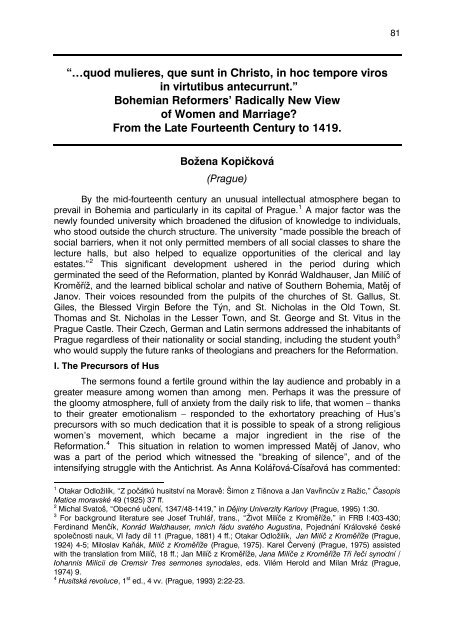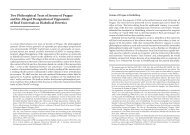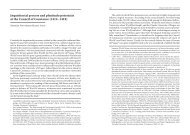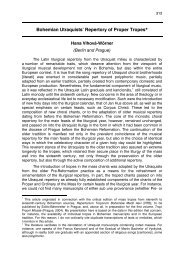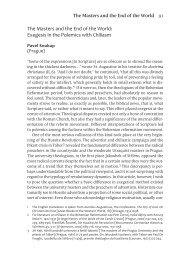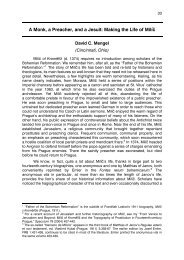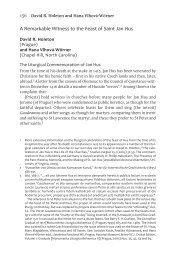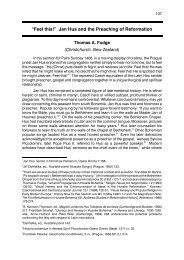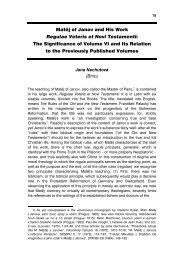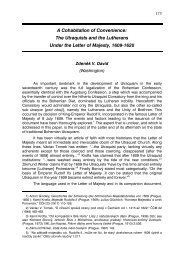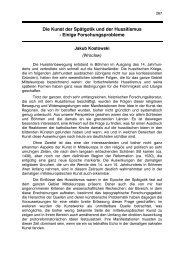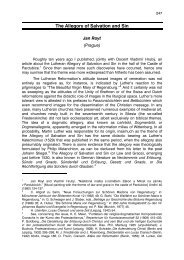quod mulieres, que sunt in Christo, in hoc - Bohemian Reformation ...
quod mulieres, que sunt in Christo, in hoc - Bohemian Reformation ...
quod mulieres, que sunt in Christo, in hoc - Bohemian Reformation ...
You also want an ePaper? Increase the reach of your titles
YUMPU automatically turns print PDFs into web optimized ePapers that Google loves.
“…<strong>quod</strong> <strong>mulieres</strong>, <strong>que</strong> <strong>sunt</strong> <strong>in</strong> <strong>Christo</strong>, <strong>in</strong> <strong>hoc</strong> tempore viros<br />
<strong>in</strong> virtutibus antecurrunt.”<br />
<strong>Bohemian</strong> Reformers’ Radically New View<br />
of Women and Marriage?<br />
From the Late Fourteenth Century to 1419.<br />
Božena Kopičková<br />
(Prague)<br />
By the mid-fourteenth century an unusual <strong>in</strong>tellectual atmosphere began to<br />
prevail <strong>in</strong> Bohemia and particularly <strong>in</strong> its capital of Prague. 1 A major factor was the<br />
newly founded university which broadened the difusion of knowledge to <strong>in</strong>dividuals,<br />
who stood outside the church structure. The university “made possible the breach of<br />
social barriers, when it not only permitted members of all social classes to share the<br />
lecture halls, but also helped to equalize opportunities of the clerical and lay<br />
estates.” 2 This significant development ushered <strong>in</strong> the period dur<strong>in</strong>g which<br />
germ<strong>in</strong>ated the seed of the <strong>Reformation</strong>, planted by Konrád Waldhauser, Jan Milíč of<br />
Kroměříž, and the learned biblical scholar and native of Southern Bohemia, Matěj of<br />
Janov. Their voices resounded from the pulpits of the churches of St. Gallus, St.<br />
Giles, the Blessed Virg<strong>in</strong> Before the Týn, and St. Nicholas <strong>in</strong> the Old Town, St.<br />
Thomas and St. Nicholas <strong>in</strong> the Lesser Town, and St. George and St. Vitus <strong>in</strong> the<br />
Prague Castle. Their Czech, German and Lat<strong>in</strong> sermons addressed the <strong>in</strong>habitants of<br />
Prague regardless of their nationality or social stand<strong>in</strong>g, <strong>in</strong>clud<strong>in</strong>g the student youth 3<br />
who would supply the future ranks of theologians and preachers for the <strong>Reformation</strong>.<br />
I. The Precursors of Hus<br />
The sermons found a fertile ground with<strong>in</strong> the lay audience and probably <strong>in</strong> a<br />
greater measure among women than among men. Perhaps it was the pressure of<br />
the gloomy atmosphere, full of anxiety from the daily risk to life, that women – thanks<br />
to their greater emotionalism – responded to the exhortatory preach<strong>in</strong>g of Hus’s<br />
precursors with so much dedication that it is possible to speak of a strong religious<br />
women’s movement, which became a major <strong>in</strong>gredient <strong>in</strong> the rise of the<br />
<strong>Reformation</strong>. 4 This situation <strong>in</strong> relation to women impressed Matěj of Janov, who<br />
was a part of the period which witnessed the “break<strong>in</strong>g of silence”, and of the<br />
<strong>in</strong>tensify<strong>in</strong>g struggle with the Antichrist. As Anna Kolářová-Císařová has commented:<br />
1<br />
Otakar Odložilík, “Z počátků husitství na Moravě: Šimon z Tišnova a Jan Vavř<strong>in</strong>cův z Ražic,” Časopis<br />
Matice moravské 49 (1925) 37 ff.<br />
2<br />
Michal Svatoš, “Obecné učení, 1347/48-1419,” <strong>in</strong> Děj<strong>in</strong>y Univerzity Karlovy (Prague, 1995) 1:30.<br />
3<br />
For background literature see Josef Truhlář, trans., “Život Milíče z Kroměříže,” <strong>in</strong> FRB I:403-430;<br />
Ferd<strong>in</strong>and Menčík, Konrád Waldhauser, mnich řádu svatého August<strong>in</strong>a, Pojednání Královské české<br />
společnosti nauk, VI řady díl 11 (Prague, 1881) 4 ff.; Otakar Odložilík, Jan Milíč z Kroměříže (Prague,<br />
1924) 4-5; Miloslav Kaňák, Milíč z Kroměříže (Prague, 1975). Karel Červený (Prague, 1975) assisted<br />
with the translation from Milíč, 18 ff.; Jan Milíč z Kroměříže, Jana Milíče z Kroměříže Tři řeči synodní /<br />
Iohannis Milicii de Cremsir Tres sermones synodales, eds. Vilém Herold and Milan Mráz (Prague,<br />
1974) 9.<br />
4 st<br />
Husitská revoluce, 1 ed., 4 vv. (Prague, 1993) 2:22-23.<br />
81
82<br />
“Matěj of Janov <strong>in</strong> his work Regulae Veteris et Novi Testamenti for the first time<br />
expressively captured the images of the new, more <strong>in</strong>tense and earnest Czech<br />
women who cooperated with their male counterparts <strong>in</strong> pav<strong>in</strong>g the road towards a<br />
<strong>Bohemian</strong> religious progress.” 5 The church reform began, accord<strong>in</strong>g to Janov, about<br />
fifty years earlier, and gathered strength from of the preachers’ sermons, and the<br />
more <strong>in</strong>tense work<strong>in</strong>gs of Christ’s spirit. Among the tell<strong>in</strong>g signs he listed the laity’s<br />
yearn<strong>in</strong>g for fre<strong>que</strong>nt communion, the revival of the spirit of humility and the flam<strong>in</strong>g<br />
love for the crucified Christ, as well as the great piety of women. 6 Referr<strong>in</strong>g to the<br />
latter, Janov stated explicitly: “I say these are the women who live accord<strong>in</strong>g to Jesus<br />
Christ and greatly excel men <strong>in</strong> the matters of faith, hope, mercy, prayer, penance,<br />
cont<strong>in</strong>ence, purity, humility, and the cultivation of specific virtues....” 7 Janov’s<br />
account dovetailed with the stories about the reform of proud and va<strong>in</strong> women, who<br />
had responded to the admonitions of Waldhauser and Milíč, and demonstrated their<br />
<strong>in</strong>ner change from the vice of pride to the virtue of humility by putt<strong>in</strong>g away the<br />
precious garments and jewels. 8<br />
Janov’s view of contemporary fem<strong>in</strong><strong>in</strong>e piety harmonized with his theological<br />
<strong>in</strong>terpretation of history. Accord<strong>in</strong>g to him, the effervescence of female piety resulted<br />
from a downward trend <strong>in</strong> the status of males who – although <strong>in</strong>itially outstand<strong>in</strong>g<br />
and superior <strong>in</strong> their power of spirit – currently became enfeebled <strong>in</strong> their thoughts,<br />
and collectively turned to the vanities and splendors of this world. As the crucified<br />
Christ once <strong>in</strong> va<strong>in</strong> had sought help among the males, so also currently he would<br />
have hardly found a place where to lay his head, <strong>in</strong>asmuch as men – one and all –<br />
had looked away and become unhelpful. Christ, therefore, turned deservedly and<br />
appropriately to the weak female gender, which was held <strong>in</strong> contempt <strong>in</strong> this world.<br />
Placed on the lowest level because of their nature’s weakness, women were now<br />
clothed <strong>in</strong> the garment of man, i.e., that of Jesus Christ. Accord<strong>in</strong>g to Janov the<br />
err<strong>in</strong>g men were transformed <strong>in</strong>to women through their weakness, while women <strong>in</strong> a<br />
manly way rose to the height of the most noble mascul<strong>in</strong>e glory, striv<strong>in</strong>g with the<br />
utmost virtue <strong>in</strong> Jesus Christ. While priests “snored and vomitted,” so that they were<br />
unworthy to serve the mass properly, women <strong>in</strong>flamed by the highest yearn<strong>in</strong>gs and<br />
<strong>in</strong>terests, hastened daily, or as fre<strong>que</strong>ntly as possible, to receive the body and blood<br />
of Jesus Christ. While men drowned <strong>in</strong> self-admiration and knew no humility, Christ<br />
5<br />
Anna Kolářová-Císařová, Žena v hnutí husitském (Prague, 1915) 44.<br />
6 nd<br />
Vlastimil Kybal, M. Matěj z Janova: jeho život, spisy a učení, 2 ed., [Pontes Pragenses 11] (Brno,<br />
2000) 150.<br />
7<br />
Matěj z Janova, Regulae I:154: “…ita dico deh<strong>in</strong>c semper us<strong>que</strong> modo ad ea, <strong>que</strong> dei <strong>sunt</strong>, ut est<br />
fidei, spei et caritatis, oracionis, penitencie, abst<strong>in</strong>encie, castitatis, humilitatis et operum misericordie<br />
at<strong>que</strong> s<strong>in</strong>gularum exercicia virtutum, <strong>mulieres</strong>, <strong>que</strong> <strong>in</strong> <strong>Christo</strong> Jhesu existunt, ut plurimum viros<br />
antecurrunt..;” ibid. 155: “H<strong>in</strong>c quo<strong>que</strong> potest evidens racio et causa illius elici, <strong>quod</strong> modico superius<br />
est assumptum, puta <strong>quod</strong> <strong>mulieres</strong>, <strong>que</strong> <strong>sunt</strong> <strong>in</strong> <strong>Christo</strong>, <strong>in</strong> <strong>hoc</strong> tempore viros <strong>in</strong> virtutibus<br />
antecurrunt.”<br />
8<br />
“Život Milíče z Kroměříže,” 406; František Loskot, Konrad Waldhauser, řeholní kanovník s. August<strong>in</strong>a,<br />
předchůdce Mistra Jana Husa, [Velicí mužové české reformace, 1] (Prague, 1909) 45-46, 84 ff;<br />
Kolářová-Císařová, Žena v hnutí husitském, 30; Jaroslav Kadlec, Mistr Vojtěch Raňkův z Ježova, [Práce<br />
z děj<strong>in</strong> University Karlovy, 7] (Prague, 1969) 87; idem, Leben und Schriften des Prager Magisters<br />
Adalbert Rankonis de Eric<strong>in</strong>io: Aus dem Nachlass von Rudolf Hol<strong>in</strong>ka und Jan Vilikovský, [Beiträge zur<br />
Geschichte der Philosophie und Theologie des Mittelalters, Texte und Untersuchungen, Neue Folge<br />
Bd. 4] (Münster, 1971) 335.
egan to bypass them and to bestow his gifts <strong>in</strong> greater measure on women. 9 “And,<br />
therefore, <strong>in</strong> these times women, virg<strong>in</strong>s and widows are raised up, and care about<br />
good morals; they undertake strict penance, rush to the holy sacraments, and take<br />
away the k<strong>in</strong>gdom of heaven from men, who are busy with the vanities of this world.<br />
It is, therefore, possible nowadays to see the female gender fill<strong>in</strong>g the churches <strong>in</strong><br />
prayers, tak<strong>in</strong>g its places at the sermons, present<strong>in</strong>g itself for confession with cries<br />
and plentiful tears, fill<strong>in</strong>g its mouth with unend<strong>in</strong>g pious promises, and joyfully<br />
receiv<strong>in</strong>g the sacrament of the altar every day. Forsak<strong>in</strong>g the splendor of the world<br />
with its delectations, the women <strong>in</strong>creas<strong>in</strong>gly abound with the love of Jesus Christ.<br />
Constantly contemplat<strong>in</strong>g holy subjects, women receive Christ’s revelations,<br />
prophecies, fre<strong>que</strong>nt visitations, and particular graces. These gifts, I say, are<br />
nowadays bestowed more on women than on whomever among men and priests.<br />
Hence it now appears that a greater prophetic faculty and more <strong>in</strong>timate<br />
acqua<strong>in</strong>tance with the Holy Spirit have been transferred to women, to whom great<br />
div<strong>in</strong>e mysteries are revealed, as to Hildegard, the glorious virg<strong>in</strong>, and to Brigid, the<br />
holy and revered matron, and – I say – to other virtuous women whom I have<br />
encountered <strong>in</strong> Prague, Rome, and Nurenberg, and by far most fre<strong>que</strong>ntly <strong>in</strong> the city<br />
of Prague.” 10 This laudable situation owed much, accord<strong>in</strong>g to Janov, to the<br />
9 Regulae I, 157: “Conformiter hic senciendum est et de fem<strong>in</strong>is, de quibus sermo, quia viri, existentes<br />
primi et maiores natu <strong>in</strong> virtute, <strong>in</strong> suis cogitacionibus evanescunt converterunt<strong>que</strong> se communiter ad<br />
vanitatem et pompam huius mundi ita, ut <strong>in</strong> eis Jhesus crucifixus <strong>que</strong>rat virum et non <strong>in</strong>veniat, sicut<br />
scriptum est… Vix habet, <strong>in</strong>quam, dom<strong>in</strong>us Jhesus <strong>in</strong> viris, ubi caput suum recl<strong>in</strong>et, quoniam omnes<br />
decl<strong>in</strong>averunt <strong>in</strong> unum, simul <strong>in</strong>utiles facti <strong>sunt</strong>; non est <strong>in</strong> eis, qui faciat bonum, non est us<strong>que</strong> ad<br />
unum. Quapropter merito et oportune dom<strong>in</strong>us virtutum et rex glorie convertit se ad <strong>in</strong>firma huius<br />
mundi et abiecta, puta ad sexum muliebrem…;” ibid. 158: “Fem<strong>in</strong>e quo<strong>que</strong>, <strong>in</strong> <strong>in</strong>fimo gradu pro<br />
condicione sue nature fragilis locate, ecce, iam virum, id est Christum Jhesum, <strong>in</strong>dute..;” ibid. 159:<br />
“…excellentissimorum virorum gloriam rapuerunt viriliter, <strong>in</strong> <strong>Christo</strong> Jhesu et <strong>in</strong> omni virtute operando,<br />
ut iam non quidem <strong>mulieres</strong>, sed virag<strong>in</strong>es merito appellentur. Nam cum sacerdotes stertunt et<br />
nauseant, vix debito et officio et alias raro missas santissimas dignari celebrare, ecce, <strong>mulieres</strong><br />
summis desideriis et studiis fest<strong>in</strong>ant cottidie, vel quanto eis sepius potest fieri, corpus et sangu<strong>in</strong>em<br />
Jhesu Christi manducare et potare…;” ibid. 162: “…dom<strong>in</strong>us suam salutem parvulis de plebe eo<br />
habundancius revelare voluit at<strong>que</strong> m<strong>in</strong>istrare, ita conformiter dicendum est <strong>in</strong> communi de<br />
comparacione virorum et mulierum quoad capacitatem donorum Jhesu Christ, quoniam <strong>in</strong> hiis diebus<br />
viri precipue, suorum bonorum naturalium seu virium conscii, nesciunt humiliare seipsos ne<strong>que</strong><br />
portare, extra castra exeundo, obprobium Jhesu Christi…Deus igitur et dom<strong>in</strong>us Jhesus, dives <strong>in</strong><br />
omnes, pro<strong>in</strong>de viris talibus relictis, ut plurimum, suos thezauros at<strong>que</strong> divicias transfert ad<br />
<strong>mulieres</strong>…”<br />
10 Ibid. 162-163: “Et per <strong>hoc</strong> istis temporibus surgunt <strong>mulieres</strong>, virg<strong>in</strong>es et vidue, et apprehendunt<br />
discipl<strong>in</strong>am, agunt strennue penitenciam, properant ad div<strong>in</strong>a sacramenta et preripiunt viris regnum<br />
celorum circa vanitatem huius seculi occupatis. Eapropter hodie est videre gentem mulierum replere<br />
templa <strong>in</strong> oracionibus, occupare loca <strong>in</strong> sermonibus, sese representare per confessionem<br />
sacerdotibus gemitibus et lacrimis uberrimis, replere maxillas cont<strong>in</strong>uis devocionibus, sumere<br />
gaudiose sacramentum altaris s<strong>in</strong>gulis diebus, perfect rel<strong>in</strong><strong>que</strong>re pompam mundi cum suis<br />
oblectacionibus, caritate Christi Jhesu magis ac magis habundantes, ea, <strong>que</strong> dom<strong>in</strong>i <strong>sunt</strong>, <strong>in</strong>cessanter<br />
cogitantes, revelaciones a <strong>Christo</strong> et prophecias visitaciones<strong>que</strong> crebras et s<strong>in</strong>ulares grate<br />
suscipientes. Hiis <strong>in</strong>quam omnibus et aliis, ut videtur, amplius cencies ditantur fem<strong>in</strong>e <strong>in</strong> <strong>hoc</strong> tempore,<br />
quam viri quicum<strong>que</strong> vel sacerdotes.<br />
Unde nunc videtur prophecia et familiaritas maior cum sancto spiritu translata ad <strong>mulieres</strong>,<br />
quibus magna misteria dei revelantur, veluti manifestum est <strong>in</strong> Hyldegarde, gloriosa virg<strong>in</strong>e, et <strong>in</strong><br />
Brigida, sancta et venerabili matrona, necnon <strong>in</strong>quam pluribus aliis dignis deo fem<strong>in</strong>is, quas Parysiis<br />
et <strong>in</strong> Roma et <strong>in</strong> Nuerberg et multo amplius <strong>in</strong> civitate Pragensi vidi, probavi et dom<strong>in</strong>um Jhesum <strong>in</strong><br />
suis operibus et dignacionem sum admiratus.” See also Kybal, Matěj z Janova 17, Rudolf Hol<strong>in</strong>ka,<br />
Sektářství v Čechách před revolucí husitskou (Prague, 1929) 115.<br />
83
84<br />
preach<strong>in</strong>g of Waldhauser and Milíč, who had addressed the female soul <strong>in</strong> fre<strong>que</strong>nt<br />
exhortations s<strong>in</strong>ce the 1360s.<br />
Turn<strong>in</strong>g to Waldhauser, he – like the other reformist preachers – expatiated <strong>in</strong><br />
particular aga<strong>in</strong>st the prostitutes, 11 but at the same time harshly criticized other<br />
women for their love of luxury and vanity. He noted also the detrimental ramification<br />
and conse<strong>que</strong>nces of ostentatious display, rem<strong>in</strong>d<strong>in</strong>g his readers that “the sweat of<br />
the poor often cl<strong>in</strong>gs to a precious garment.” 12 In their proud narcissism women<br />
could cause economic and social difficulties to their families with their lavish<br />
expenditures. 13 Tomáš Štítný of Štítné and Jan Hus would later put forth similar<br />
views. 14 While reject<strong>in</strong>g expensive cloth<strong>in</strong>g for women without any exception,<br />
Waldhauser approved luxuries for men for justifiable reasons of their status, such as<br />
the customary attire of popes, monarchs, and bishops, or for dist<strong>in</strong>guish<strong>in</strong>g the<br />
gradation among masters and pr<strong>in</strong>ces. 15 Already this assessment of external<br />
appearance <strong>in</strong>directly <strong>in</strong>dicated the double standard applied to the two genders.<br />
More important is the preacher’s evidently higher valuation of the male gender which<br />
found its way to the surface with<strong>in</strong> the flood of other thoughts <strong>in</strong> his statement:<br />
“…when a woman gives birth to a son, she rejoices more than over the birth of a<br />
daughter.” 16 The joy was here clearly justified by the higher value of the male,<br />
because for Waldhauser a woman was primarily a symbol of physical attraction, and<br />
hence – as for Vojtěch of Ježov – above all a carrier of the sexual function, which<br />
spelled an <strong>in</strong>vitation to pleasure, <strong>in</strong> other word an <strong>in</strong>vitation to s<strong>in</strong>. The one<br />
justification for female sexuality was motherhood. In harmony with contemporary<br />
reverence, Waldhauser likewise esteemed most highly the Virg<strong>in</strong> Mary as the Mother<br />
of God. This is evident also from the Old Czech version of Waldhauser’s homiliary<br />
[Postila], which may be considered a guide to his teach<strong>in</strong>g, albeit somewhat altered<br />
from the orig<strong>in</strong>al. Every protheme ended by the angelic salutation of “Hail Mary”, 17<br />
with an added plea for the Mother of God’s <strong>in</strong>tercession. To this reverence was<br />
related a respect of the contemporary earthly expectant mothers, that is pregnant<br />
women, whom the preacher placed high – right next to the Apostles. 18 He did not<br />
rema<strong>in</strong> <strong>in</strong>different to the omnipresent suffer<strong>in</strong>g of a woman <strong>in</strong> the life-threaten<strong>in</strong>g<br />
situation of giv<strong>in</strong>g birth: “As you know, the grave is always open, and death is always<br />
wait<strong>in</strong>g for every pregnant woman. Therefore, she rejoices [after a successful birth]<br />
that she escaped unscathed.” 19 It was probably due to the pervasiveness of the<br />
Marian cult that Waldhauser adopted a compassionate tone toward the woman<br />
giv<strong>in</strong>g birth. It was likely for the same reason that he eschewed the harsh words of<br />
the Bible, re<strong>in</strong>forced by comments of church authorities, which ascribed the woman’s<br />
11<br />
Kolářová-Císařová, Žena v hnutí husitském 32.<br />
12<br />
Loskot, Konrád Waldhauser 43; Kolářová-Císařová, Žena v hnutí husitském 28-29.<br />
13<br />
Loskot, Konrád Waldhauser 41; Husitská revoluce 2:38.<br />
14<br />
Pavlína Rychterová, “Žena a manželství v díle Tomáše ze Štítného,” Mediaevalia Historica Bohemica<br />
6 (1999) 95-109; Výbor z české literatury doby husitské, eds. Bohuslav Havránek and others, 2 vols.<br />
(Prague, 1963-1964) 1:105.<br />
15<br />
Staročeské zpracování Postily studentů svaté university pražské Konráda Waldhausera, ed. František<br />
Šimek, Sbírka pramenů českého hnutí náboženského ve XIV. a XV. století, sv. 20 (Prague, 1947) xiv.<br />
16<br />
Ibid. 25.<br />
17<br />
Ibid. xii and passim.<br />
18<br />
Ibid. 24, 26.<br />
19<br />
Ibid. 25.
irth pangs to the penalty for the s<strong>in</strong> committed by the primal mother Eve <strong>in</strong><br />
Paradise. 20<br />
Accord<strong>in</strong>g to Waldhauser’s op<strong>in</strong>ion, the Virg<strong>in</strong> Mary was not alone among<br />
women <strong>in</strong> her hol<strong>in</strong>ess and election. Among the elect were likewise the holy women,<br />
who were the first to come to Christ’s empty tomb so that they alone might announce<br />
to the entire world, through the Apostles, the miracle of the Resurrection. 21 Hence<br />
Waldhauser recognized the chosen women’s right to sanctity.<br />
Jan Milíč of Kroměříž with his basically negative stance toward women approached<br />
closely the misogynously <strong>in</strong>cl<strong>in</strong>ed church authorities, accord<strong>in</strong>g to which women<br />
brought evil to the world. This evil endangered men with a perpetual seductiveness.<br />
It affected not only laymen, but also priests, as shown by ecclesiastics’ <strong>in</strong>volvement<br />
<strong>in</strong> adultery and fornication, as well as <strong>in</strong> their embrac<strong>in</strong>g of luxurious fashions <strong>in</strong> order<br />
to attract female attention. 22 The preacher drew a lesson from the danger of female<br />
seductiveness for his own relationship with the opposite sex, which corresponded to<br />
St. Jerome’s rule, namely that the safest conduct was to avoid touch<strong>in</strong>g a woman<br />
under any circumstances. 23 He applied this maxim with a vengeance <strong>in</strong> his often<br />
bizarre detachment from women, as it is attested by sources which historians have<br />
utilized with relish. 24 Guided by his convictions, Milíč recalled the connection<br />
between the woman and the devil which, start<strong>in</strong>g with the earliest biblical exegetes,<br />
had become a cherished explanation of the topos of Adam and Eve <strong>in</strong> the Garden of<br />
Paradise accord<strong>in</strong>g to the book of Genesis. Seen through these commentators’<br />
misogynous spectacles, the medieval woman (as daughter of the primeval mother,<br />
Eve) rema<strong>in</strong>ed a perpetual s<strong>in</strong>ner, with Satan constantly lurk<strong>in</strong>g <strong>in</strong> her presence.<br />
Milíč applied this l<strong>in</strong>kage particularly to prostitutes, who <strong>in</strong> his m<strong>in</strong>d were fully<br />
identified with the devil. These women snared impure men <strong>in</strong> their dalliance <strong>in</strong> order<br />
to kill their souls. 25 As a part of his duel with Antichrist, he might have perceived the<br />
disruption of the diabolic alliance as one of the reasons for the conversion of the<br />
20<br />
Gen 3:16; 2 Thess 2:14-15. See also Thérèse d’Alverny, “Comment les théologiens et les<br />
philosophes voient la femme,” Cahiers civilisation médiévale X e -XII e sciècles 20 (1977) 114.<br />
21<br />
Staročeské zpracování Postily 9 ff.<br />
22<br />
Herold and Mráz, eds., Jana Milíče z Kroměříže Tři řeči synodní 62, 64-65, 93: “Sic et nunc<br />
sacerdotes sibi <strong>in</strong>iquitates congregant, nunc adulteriis, fornicacionibus, <strong>in</strong>cestibus carnalibus,<br />
mulierum amoribus, osculis, amplexibus concub<strong>in</strong>arum, cohabitacionibus meretricum… Rogo, unde<br />
est <strong>hoc</strong>, <strong>quod</strong> quidam verecundantur vocari sacerdotes… Quidam ocreas pedibus diligenter adaptant<br />
, ne ali<strong>que</strong> ruge appareant, et sic calceos sive sotulares strictos deferunt et rostratos, ut oculis<br />
hom<strong>in</strong>um et precipue mulieribus placeant.”<br />
23<br />
See, for <strong>in</strong>stance, Gabriele Becker, Helmut Brackert, Sigrid Brauner, and Angelika Tümmler, “Zum<br />
kulturellen Bild und zur realen Situation der Frau <strong>in</strong> Mittelalter und <strong>in</strong> der frühen Neuzeit,” <strong>in</strong> Aus der<br />
Zeit der Verzweiflung: Zur Genese und Aktualität des Hexenbildes (Frankfut a. M., 1977) 18. Jerome’s<br />
misogynous views also affected Hus and most of his precursors (even Janov, although <strong>in</strong> a limited<br />
way). Likewise the layman Štítný deferred to them.<br />
24<br />
“Život Milíče z Kroměříže,” 407; Kolářová-Císařová, Žena v hnutí husitském 31-32; Kaňák, Milíč z<br />
Kroměříže 35.<br />
25<br />
Herold and Mráz, eds., Jana Milíče z Kroměříže Tři řeči synodní 123: “…sed ipsum pocius<br />
dyabolum, qui stat a dextris eorum, id est mulier fornicaria…;” ibid., 125-126: “Et Crisostomus Super<br />
Matheum Morali 48 dicit lo<strong>que</strong>ns de Herodiade, quomodo idem demon adhuc saltat <strong>in</strong> corizantibus,<br />
sic <strong>in</strong>quiens: ‘…Cum enim meretrices construant, non caput <strong>in</strong>terficiunt, sed animam occidunt<br />
fornicarios operantes. Etsi non filia Herodiadis adest, sed adest ille, qui per illam saltavit tunc<br />
dyabolus, eciam per hanc saltat nunc et animas convivancium captivas arripiens abit’.”<br />
85
86<br />
prostitutes, and the erection of a sanctuary for them, called Jerusalem. 26 Of course,<br />
his natural sympathy and magnanimity also played a role. 27 In the case of Milíč this<br />
possibility can not be ruled out, firmly anchored as he was <strong>in</strong> the medieval<br />
Weltanschauung. His rehabilitation of prostitutes and protection of penitent women 28<br />
performed <strong>in</strong> a different manner the same function as Jan Želivský’s subse<strong>que</strong>nt<br />
destruction of brothels. Both represented a liquidation of the houses of prostitution,<br />
although <strong>in</strong> different ways. In fact, Milíč, properly speak<strong>in</strong>g, applied the second<br />
method as well when he caused a demolition of the bordello, known as “Benátky”<br />
[Venice]. 29 Just as Jesus had freed Mary Magdalene from the power of the seven<br />
demons, Milíč extracted the prostitutes from diabolical clutches. He then took good<br />
care of the penitent women, who surrounded him, and – like Mary Magdelene <strong>in</strong> the<br />
case of Jesus – accompanied him <strong>in</strong> his later life, until his departure for Avignon. As if<br />
to underl<strong>in</strong>e the connection, he had a chapel erected <strong>in</strong> honor of Mary Magdalene. A<br />
comb<strong>in</strong>ation of the holy woman’s evangelical message with his struggle aga<strong>in</strong>st the<br />
Antichrist helped to expla<strong>in</strong> the apparent contradiction between his misogynist<br />
theories and the morbid detachment <strong>in</strong> his personal contact with women, on the one<br />
hand, and his devoted daily care for the penitent prostitutes, on the other.<br />
Beside Mary Magdalene, Milíč showed a fervent devotion to the Virg<strong>in</strong> Mary,<br />
not only accord<strong>in</strong>g to contemporary conventions, but also as an expression of his<br />
own <strong>in</strong>nermost conviction. He repeatedly cited the angelic greet<strong>in</strong>g “Ave Maria” <strong>in</strong> his<br />
synodal sermons. 30 The feast day of Mary’s birth occupied a special place among his<br />
Sunday and holiday sermons. 31 At his bidd<strong>in</strong>g, the prayer “Hail Holy Queen”<br />
resounded as an expression of Marian veneration after Friday sermons at the<br />
Jerusalem foundation. 32<br />
Return<strong>in</strong>g to the earlier-mentioned views of Matěj of Janov concern<strong>in</strong>g<br />
women’s grow<strong>in</strong>g piety, it was evident that this biblical scholar did not regard women<br />
as creatures of a lower order than men but, to the contrary, <strong>in</strong> certa<strong>in</strong> respects valued<br />
them more highly. In disregard of gender, he posited the rules [regulae] for the<br />
differentiation between the true and the false Christians. The former, who <strong>in</strong>cluded<br />
women as well as men, were to be admitted to fre<strong>que</strong>nt communion without any<br />
restriction. Janov used as the fundamental source and model for his gender-bl<strong>in</strong>d<br />
stance the theological lore of Scripture, 33 and disregarded those church doctors and<br />
other authorities who – appeal<strong>in</strong>g to St. Paul – had promoted a strongly misogynist<br />
l<strong>in</strong>e of thought. 34 Largely freed from this dependence, he arrived <strong>in</strong> his speculation<br />
about true Christians to such a favorable female image that he excelled over other<br />
ecclesiastical authorities labour<strong>in</strong>g toward a more pro-fem<strong>in</strong><strong>in</strong>e po<strong>in</strong>t of view. The<br />
latter pioneers, more often philosophers than theologians, grounded their optimistic<br />
views <strong>in</strong> the veneration of Mary, and postulated an antithesis between the s<strong>in</strong>ful Eve<br />
26<br />
“Život Milíče z Kroměříže,” 418 ff. For a survey of literature on this subject see also Božena<br />
Kopičková, “Žena a rod<strong>in</strong>a v husitství,” HT 12 (1999) 40.<br />
27<br />
For a testimony of admiration see Matěj z Janova, “Matěje z Janova Zpráva o Milíčovi z Kroměříže,”<br />
FRB I:431-436; concern<strong>in</strong>g Milíč’s <strong>in</strong>fluence on Janov see, for <strong>in</strong>stance, Kybal, Matěj z Janova 22.<br />
28<br />
Výbor z české literatury doby husitské 1:49.<br />
29<br />
Kolářová-Císařová, Žena v hnutí husitském 33.<br />
30<br />
Herold and Mráz, eds., Jana Milíče z Kroměříže Tři řeči synodní 75, 105.<br />
31<br />
František M. Bartoš, Dvě studie o husitských postilách 6.<br />
32<br />
Kolářová-Císařová, Žena v hnutí husitském 34.<br />
33<br />
Kybal, Matěj z Janova 33 ff.<br />
34<br />
Ibid. 47.
of the Old Testament, and Mary, the New Testament Mother of God, who had<br />
overshadowed the del<strong>in</strong><strong>que</strong>nt primal mother. 35 As it will be shown later, this<br />
antithesis – rooted <strong>in</strong> a reverence for the Virg<strong>in</strong> Mary – was found not only <strong>in</strong> Janov,<br />
but also <strong>in</strong> Tomáš Štítný and Jan Hus.<br />
Matěj of Janov further emphasized, also <strong>in</strong> the spirit of Waldhauser, that the<br />
Mother of God would be followed by holy and pious women who, as objects of a<br />
special div<strong>in</strong>e benevolence, would be chosen to enunciate, through the Apostles, the<br />
Resurrection of Christ. 36<br />
It is possible to state without any exaggeration that Janov adopted toward<br />
those women, whom he considered true Christians, a viewpo<strong>in</strong>t that was<br />
exceptionally positive, even radically progressive. In l<strong>in</strong>e with his conviction that<br />
every true Christian had the right to the fre<strong>que</strong>nt reception of the sacrament of the<br />
altar, he firmly opposed other theological savants who would have excluded all<br />
women from fre<strong>que</strong>nt communion on the grounds of an <strong>in</strong>herent weakness and<br />
superficiality of their gender. 37 Janov agreed with this limitation only <strong>in</strong> the cases of<br />
unworthy women, that is false Christians, who <strong>in</strong>cluded not only prostitutes, but all<br />
women marked by superficiality of m<strong>in</strong>d and impropriety of behaviour, for whom he<br />
favoured only an annual reception of the holy sacrament. 38 Evidently he referred to<br />
the pretentious and fashionably dressed seductresses whom Waldhauser and Milíč<br />
had also criticized. 39 Otherwise, however, not even the greatest theologians had the<br />
right, accord<strong>in</strong>g to Janov – the Church’s permission notwithstand<strong>in</strong>g – to deprive the<br />
female gender <strong>in</strong> its entirety of the benefits of fre<strong>que</strong>nt communion. Evidently, he<br />
opposed the application of an undifferentiated discrim<strong>in</strong>ation aga<strong>in</strong>st the entirety of<br />
womank<strong>in</strong>d.<br />
He found it necessary to rem<strong>in</strong>d his audience that it was improper to bar<br />
females from fre<strong>que</strong>nt communion on the basis of a putative <strong>in</strong>tellectual and spiritual<br />
35 These authorities <strong>in</strong>cluded <strong>in</strong> particular Isidor of Seville, Anselm of Canterbury, Peter Abélard,<br />
members of the Victor<strong>in</strong>e school of mystical theology <strong>in</strong> Paris, <strong>in</strong>clud<strong>in</strong>g Peter Lombard, Hugh, and<br />
others. Thus it was ma<strong>in</strong>ly under the <strong>in</strong>fluence of philosophers and polymath scholars that two<br />
differentiated ideological or cultural currents clearly crystallized, as noted already by Pavel Spunar,<br />
“Žena, manželství a rod<strong>in</strong>a v počátcích české reformace,” <strong>in</strong> Příspěvky k děj<strong>in</strong>ám křesťanství (Prague,<br />
1991) 165-166. Concern<strong>in</strong>g the above th<strong>in</strong>kers see also d’Alverny, “Comment les théologiens,” 117 ff.<br />
More generally concern<strong>in</strong>g this issue see at least “Die Eva-Maria-Typologie,” Handbuch der<br />
Marienkunde, eds., Wolfgang Be<strong>in</strong>ert and He<strong>in</strong>rich Petri, 2d ed. rev. Vol. 1: Theologische<br />
Grundlegung Geistliches Leben 369 ff.<br />
36 Regulae I:154 “…<strong>quod</strong> scilicet nunc et semper <strong>in</strong> <strong>Christo</strong> sancte <strong>mulieres</strong> tam virtuose vivunt et<br />
vixerunt sicut confavente eisdem div<strong>in</strong>a bonitate, ut contemptum sue matris Eve reformarent, <strong>quod</strong><br />
sicut <strong>mulieres</strong> viros precesserunt <strong>in</strong> suscipiendo Christum <strong>in</strong> hunc mundum ac omnium virtutum<br />
primordia, veluti patet <strong>in</strong> Maria, dei matre gloriosa, suscipiendo quo<strong>que</strong> Christum Jhesum ab <strong>in</strong>feris<br />
per resurreccionem revertentem, <strong>que</strong>madmodum manifestum est <strong>in</strong> Maria Magdalena et aliis duabus,<br />
quibus datum est, ut apostolis, beatis viris, ipse essent apostole nunccie<strong>que</strong> resurreccionis dom<strong>in</strong>i<br />
Jhesu Christi…”<br />
37 On the discussion about fre<strong>que</strong>nt communion, which had engaged theologians s<strong>in</strong>ce the midfourteenth<br />
century, see, for <strong>in</strong>stance, Kadlec, Mistr Vojtěch Raňkův z Ježova 37 ff . and Jaroslav V.<br />
Polc, “Časté přijímání laiků: základ české reformace. Duchovní proudy od Karla IV. ke kalichu,” and “<br />
Disputace o častém přijímání laiků na předhusitské teologické fakultě,” <strong>in</strong> his Česká církev v děj<strong>in</strong>ách<br />
(Prague, 1999) 207-229, 231-239.<br />
38 Spunar, “Žena, manželství a rod<strong>in</strong>a,” 168.<br />
39 Ibid.<br />
87
88<br />
weakness, or the lack of physical prowess. 40 Such argumentation was <strong>in</strong>valid<br />
because not even the Prophets or the Apostles drew any dist<strong>in</strong>ction between men<br />
and women <strong>in</strong> the admissibility to the sacrament. Janov emphasized that improper<br />
behaviour was the attribute of human be<strong>in</strong>gs regardless of gender, contrary to the<br />
op<strong>in</strong>ion of those scholars who ma<strong>in</strong>ta<strong>in</strong>ed that women were of a lesser worth than<br />
men when it came to the reception of communion. 41 Contradict<strong>in</strong>g canonical texts,<br />
they divided what God had put together, <strong>in</strong>asmuch as Jesus Christ assembled<br />
equally all <strong>in</strong> his mystical body accord<strong>in</strong>g to the truth and the spirit without mak<strong>in</strong>g a<br />
dist<strong>in</strong>ction between male and female. The first and primeval Lord had endowed all<br />
equally, both men and women. His deputies, that is the priests, should act<br />
accord<strong>in</strong>gly. 42 The <strong>in</strong>discrim<strong>in</strong>antly negative view of women was also clearly<br />
negated by Scripture which elevated virg<strong>in</strong>s, widows and married women, endowed<br />
them with diverse titles of dist<strong>in</strong>ction, and conferred bless<strong>in</strong>gs on them. 43<br />
Let us now briefly exam<strong>in</strong>e the views of Hus’s precursors on marriage.<br />
Waldhauser recognized the necessity of marriage for the preservation of humanity,<br />
and hence he held motherhood <strong>in</strong> high esteem. Despite this fundamental function,<br />
however, the Austrian preacher did not condone the marital state without reservation,<br />
40 Regulae I:151, 163-164 “Sunt adhuc quidam et magni viri, qui <strong>in</strong> suis scriptis reli<strong>que</strong>runt, <strong>quod</strong><br />
scilicet maxime mulieribus non sit istud maiestatis sacramentum cottidie vel alias sepe m<strong>in</strong>istrandum,<br />
tum quia <strong>sunt</strong> vel solent esse <strong>in</strong>munde a facie passionis menstruorum, tum quia <strong>sunt</strong> communiter<br />
leves persone et per conse<strong>que</strong>ns facile transmutabiles <strong>in</strong> earum coversacione ad oppositam<br />
qualitatem.<br />
Et istos, ut verum fatear, magis libet mirari quam imitari…puta non ad omnes fem<strong>in</strong>as, sed<br />
solum ad illas, <strong>que</strong> degenerantes a christiana morum gravitate, se prorsus <strong>in</strong>dignas faciunt seu<br />
exhibent, non dico crebra, sed eciam annua communione sacramenti per mentem suam fluxam et<br />
despicabilem conversacionem et <strong>in</strong>mundam. Quod si sic <strong>in</strong>telligunt, tunc non videbitur racio, quare<br />
tantum sexum mulierem <strong>hoc</strong> dicendo expresserunt…De secundo autem, puta de passione<br />
menstruorum, scilicet <strong>quod</strong> non <strong>in</strong>pediant <strong>mulieres</strong> alias dignas sepe vel cottidie sacramento altaris<br />
communicare…Illi enim, qui tales <strong>in</strong>firmitates naturales, <strong>que</strong> <strong>sunt</strong> s<strong>in</strong>e omni culpa et mentis<br />
contagione, <strong>in</strong> Christi fidelibus magnipendunt, multum preferre frontem phariseorum videntur, duci<br />
solum iudicio corporali, quia illa <strong>in</strong> lege perfecta ewangelica non pensantur…” See also Spunar, ,<br />
“Žena, manželství a rod<strong>in</strong>a,” 169, 179; František Šmahel, “Cherchez la femme…Ženská <strong>in</strong>iciativa v<br />
husitství,” <strong>in</strong> Xenia Spunariana (1988) 45-46 [<strong>in</strong> manuscript].<br />
41 Regulae I:152, 154 “…Quem populum sancti prophete et apostoli per multa extollentes, nullibi <strong>in</strong>ter<br />
viros et <strong>mulieres</strong> fecerunt ullam seccionem et pr<strong>in</strong>cipaliter quoad div<strong>in</strong>orum sacramentorum<br />
exercicium et fruicionem…illa manifeste notant vicium animorum tam viri quam fem<strong>in</strong>e, sed non<br />
sexum vel naturam fem<strong>in</strong>arum…Item si viri secundum illos digniores essent habiti vel sepe vel cottidie<br />
<strong>hoc</strong> gratissimum sacramentum biberent, et manducarent quam <strong>mulieres</strong>, procul dubio <strong>hoc</strong> non esset<br />
racione sexus, quia ille nichil facit ad propositum salutis <strong>in</strong> <strong>Christo</strong> Jhesu secundum paulo ante<br />
allegata…ergo illud esset maxime racione virtutis animi et conversacionis digne <strong>in</strong> religione<br />
christiana.”<br />
42 Regulae I:153 “Enimvero videntur isti contra decreta canonis disiungere id, <strong>quod</strong> deus coniunxit,<br />
quoniam dom<strong>in</strong>us Jhesus Christus congregavit omnes pariter <strong>in</strong> suum corpus misticum secundum<br />
veritatem et spiritum, nullam faciens <strong>in</strong>ter <strong>mulieres</strong> vel masculos differenciam…Quo contra isti<br />
<strong>in</strong>dulgent viri sepe tradi corpus et sangu<strong>in</strong>em, fem<strong>in</strong>as autem <strong>in</strong>de censent excludendas, cum tamen<br />
manifeste dicit apostolus, <strong>quod</strong> <strong>in</strong> <strong>Christo</strong> Jhesu ne<strong>que</strong> vir s<strong>in</strong>e muliere ne<strong>que</strong> mulier s<strong>in</strong>e<br />
viro…Sana<strong>que</strong> racio istorum, de quibus sermo, expugnat op<strong>in</strong>ionem, qui iudicant <strong>mulieres</strong> esse<br />
<strong>in</strong>feriores viris quoad crebram sacramenti altaris communionem. Et primo sic: Illud, <strong>quod</strong> est primo et<br />
pr<strong>in</strong>cipali dom<strong>in</strong>o omnibus e<strong>que</strong> datum et concessum, tam mulieribus quam viris, [a] dispensatoribus<br />
debet similiter illud utris<strong>que</strong> poscentibus equaliter m<strong>in</strong>istrari.”<br />
43 Ibid. “At ne<strong>que</strong> op<strong>in</strong>ioni ipsorum concordat sancta scriptura, sed magis adversatur quantum ad id,<br />
<strong>quod</strong> <strong>in</strong>dignificant eciam preclaram et castam generacionem virg<strong>in</strong>um et viduarum nec non<br />
coniugatarum beatarum, cum tamen sancta scriptura multis laudam easdem preconiis extollit<br />
variis<strong>que</strong> titulis privilegiorum dotat et benedicit.”
comment<strong>in</strong>g critically that “many unite with women not for child bear<strong>in</strong>g, but for<br />
satisfaction of carnal desires.” 44 The physical passion made matrimony very<br />
dangerous, because husbands made excessive efforts to be attractive to their<br />
wives. 45 Milíč’s <strong>in</strong>terpretation of marriage was marked by the same ambivalence. He<br />
postulated its triple role <strong>in</strong> harmony with the August<strong>in</strong>ian tradition: a spousal union<br />
was consummated as a sacrament, assured mutual fidelity, and provided offspr<strong>in</strong>g.<br />
Although Milíč did not deny the value of marital cohabitation, he still – like<br />
Waldhauser – enterta<strong>in</strong>ed a dark shadow of suspicion about its moral status. These<br />
doubts were reflected <strong>in</strong> his praises of childless marriages, which <strong>in</strong>volved a strict<br />
sexual abst<strong>in</strong>ence [abs<strong>que</strong> copula carnis]. 46 Contrary to his two predecessors, Matěj<br />
of Janov saw no risk <strong>in</strong> marriage even for the mascul<strong>in</strong>e side. Referr<strong>in</strong>g to Scripture<br />
and to St. Ambrose, he stressed that God gave man a buttress [adiutorium bonum] <strong>in</strong><br />
his wife. Moreover, he did not adopt Ambrose’s qualification that the female<br />
contribution to the spousal relationship was of an <strong>in</strong>ferior order. 47 He understood<br />
marriage as a genu<strong>in</strong>e partnership and gave no sign of agreement with the<br />
entrenched medieval view accord<strong>in</strong>g to which the husband served as a master and<br />
guardian of the wife. Janov did not see anyth<strong>in</strong>g risky or despicable <strong>in</strong> the<br />
bridegroom’s attachment to his bride. Rather <strong>in</strong> agreement with Hildegard of B<strong>in</strong>gen<br />
– a mystic much favoured <strong>in</strong> the <strong>Bohemian</strong> reformist milieu 48 – he argued for, and<br />
stressed, the div<strong>in</strong>e <strong>in</strong>tent accord<strong>in</strong>g to which a husband and a wife should become<br />
one flesh <strong>in</strong> the unity of love. The spiritual foundations for a mutual understand<strong>in</strong>g<br />
were already laid dur<strong>in</strong>g the engagement to be married. Matěj addressed the spousal<br />
condition also from the standpo<strong>in</strong>t of fre<strong>que</strong>nt communion and, from this<br />
perspective, established rules to foster marital cohabitation, which have attracted<br />
fre<strong>que</strong>nt attention of historians. 49<br />
In the spirit of Jerome and August<strong>in</strong>e and <strong>in</strong> the footsteps of Milíč, 50 whom he<br />
adored, the lay author Tomáš Štítný likewise warned aga<strong>in</strong>st the female snares. He<br />
noted: “St. Jerome says: ‘To see a woman is evil, because she is a stimulus; to hear<br />
her is worse, because thereby the devil releases his poison; and to touch her is the<br />
worst, because it destroys purity.’ And St. August<strong>in</strong>e confirms this….” 51 Based on his<br />
own experiences, Štítný exempted good housekeepers and wives from the ranks of<br />
dangerous females. In agreement with Milíč, he postulated the three ma<strong>in</strong><br />
August<strong>in</strong>ian components of marriage: fidelity, offspr<strong>in</strong>g (for the preservation of race),<br />
and sacrament. 52 Unlike the clerics, he could evaluate the spousal cohabitation from<br />
his own personal practice. In prais<strong>in</strong>g the virtues of women, who nurtured their<br />
families and households, the widowed author was project<strong>in</strong>g his own feel<strong>in</strong>gs toward<br />
44<br />
Staročeské zpracování Postily 72.<br />
45<br />
Ibid.<br />
46<br />
Spunar, “Žena, manželství a rod<strong>in</strong>a,” 166.<br />
47<br />
D’Alverny, “Comment les théologiens,” 109.<br />
48<br />
See, for <strong>in</strong>stance, Václav Novotnv, Náboženská hnutí česká ve 14. a 15. století, část 1: Do Husa<br />
(Prague, n.d.) 155; Husitská revoluce 2:204; Anežka Vidmanová, “Ke staroboleslavskému husitskému<br />
kodexu,” StR 31 (1995-96) 22.<br />
49<br />
Kybal, Matěj z Janova 273, and most recently Polc, “ Vita coniugale e communione quotidiana dei<br />
laici <strong>que</strong>stione disputata a Praga alla f<strong>in</strong>e del sec. XIV,” Česká církev v děj<strong>in</strong>ách 169-205.<br />
50<br />
Tomáš ze Štítného, Knížky šestery o obecných věcech křesťanských, ed. JaromRr Erben (Prague,<br />
1852) xvi.<br />
51<br />
Ibid. 76.<br />
52<br />
Jan Gebauer, “O životě a spisích Tomáše ze Štítného,” <strong>in</strong> Tomáš ze Štítného, Spisy, v. 1:<br />
Prolegomena (Prague, 1923) 46.<br />
89
90<br />
a late spouse, for whom he cont<strong>in</strong>ued to grieve and whom he respected as his<br />
children’s mother. 53 Yet, despite his high valuation of the spousal relationship, 54<br />
which imposed duties on husbands toward their wives, 55 Štítný still postulated the<br />
requirement of wives’ obedience and subord<strong>in</strong>ation to their husbands. He followed<br />
St. Paul’s <strong>in</strong>junction “Wives be subord<strong>in</strong>ate to your husbands.” 56 In order to illustrate<br />
the marital relationship, the rustic theologian availed himself of a simile put forth by<br />
the earlier mentioned Hildegard von B<strong>in</strong>gen, who compared a housewife to the<br />
moon. As the latter derived its beauty from the sun, the former owed her honour to<br />
the husband. 57 The householder had to rear his wife as well as the household staff,<br />
and Štítný accord<strong>in</strong>gly taught that it was the responsibility of the head of the<br />
household to prevent “his wife and the rest of the household” from fall<strong>in</strong>g <strong>in</strong>to vice<br />
and evil. First of all, he was to do so by example, k<strong>in</strong>dness, and admonition, but “if<br />
goodness failed to affect them, he had the right to unleash his power of dom<strong>in</strong>ion.” 58<br />
Evidently, the householder was thus authorized to employ harsher means not only<br />
toward the servants, but also toward his wife. She, <strong>in</strong> her turn, was unable to<br />
reciprocate <strong>in</strong> k<strong>in</strong>d, as Štítný considered self-evident, and counseled the wife that she<br />
had no other choice but turn<strong>in</strong>g to God <strong>in</strong> order to alleviate any hardships, which her<br />
spouse might have <strong>in</strong>flicted on her. 59<br />
Respect<strong>in</strong>g the memory of his late wife and his children’s mother, and<br />
affected by the atmosphere of a pronounced Marian cult, Štítný like his predecessors<br />
expressed with a genu<strong>in</strong>e feel<strong>in</strong>g the panegyric to Mary’s motherhood and virg<strong>in</strong>al<br />
purity <strong>in</strong> his “Explication of Hail Mary” [Výklad na ‘Zdrávas Maria]. 60 Follow<strong>in</strong>g a<br />
number ecclesiastical authorities, and perhaps particularly affected by Matěj of<br />
Janov, he did not forget to emphasize Mary’s special favour to womanhood when:<br />
“…through her the curse of Eve had been lifted from her entire race which had<br />
become eligible for eternal life thanks to the blessed fruit of her womb…” 61<br />
II. Hus, Jakoubek, and Želivský<br />
Although Jan Hus also discharged many critical salvos <strong>in</strong>to the female ranks, it<br />
is important to note that – like Janov – he avoided generaliz<strong>in</strong>g such vituperations.<br />
He dist<strong>in</strong>guished virtuous and vicious women apply<strong>in</strong>g the yardstick of s<strong>in</strong>fulness<br />
because for him s<strong>in</strong>, not gender, was the criterion. 62 The virtuous group represented<br />
for him true Christians whom he viewed with k<strong>in</strong>dness and affection. These moral,<br />
pious, and genu<strong>in</strong>ely religious women had already undergone an <strong>in</strong>ternal renewal<br />
under the <strong>in</strong>fluence of his precursors. Such paragons not only formed the core of the<br />
53<br />
Rychterová, “Žena a manželství,” 103-107.<br />
54<br />
Ibid. 106-107.<br />
55<br />
Gebauer, “O životě a spisích,” 44 ff.<br />
56<br />
Tomáš ze Štítného, Knížky šestery 105: “…likewise a humble and wise housewife…from true love<br />
will obey her husband, listen<strong>in</strong>g to the words of St. Paul, who says: ‘Wives be subject to your<br />
husbands’ …”<br />
57<br />
Ibid. 100: “A wise and noble housewife is compared to the moon. As the moon takes all its beauty<br />
from the sun, so also she has her honor from her husband…” It is a mere variant of Heldegard’s<br />
dictum that a woman receives her strength from her husband, as the moon does from the sun; see<br />
D’Alverny, “Comment les théologiens,” 123.<br />
58<br />
Tomáš ze Štítného, Knížky šestery 98.<br />
59<br />
Ibid. 106.<br />
60<br />
Ibid. 287-298.<br />
61<br />
Ibid. 288.<br />
62<br />
Jan Hus, Výklady Opera omnia I:320.
Bethlehem community, but also belonged to the wider fem<strong>in</strong><strong>in</strong>e circle surround<strong>in</strong>g<br />
Hus, who did not spare the words of praise and gratitude toward them <strong>in</strong> his<br />
sermons and writ<strong>in</strong>gs. 63 Nevertheless, even his praise betrayed an underestimation<br />
of the fem<strong>in</strong><strong>in</strong>e k<strong>in</strong>d. In a left-handed compliment, he placed the sa<strong>in</strong>tly (and<br />
apparently also the pious) women on a higher pedestal than the males of equal<br />
religious atta<strong>in</strong>ments because of the females’ more corrupt nature, the tam<strong>in</strong>g of<br />
which he found more demand<strong>in</strong>g. Because of this exceptionally corrupt nature, the<br />
<strong>in</strong>ternal struggle between good and evil was much more exact<strong>in</strong>g for women than for<br />
men, and hence the female victory was particularly meritorious <strong>in</strong> the eyes of God. 64<br />
As an extenuat<strong>in</strong>g circumstance it must be noted that Hus adopted this ungallant<br />
attitude from Peter Comestor, 65 who was much favored by the <strong>Bohemian</strong> <strong>in</strong>tellectual<br />
milieu so that his Historia scholastica had been translated <strong>in</strong>to Czech by the end of<br />
the fourteenth century. 66<br />
Accord<strong>in</strong>g to Hus, the sa<strong>in</strong>tly women enjoyed an undeniable right to the status<br />
of the elect, because it was exactly they who first had come upon Christ’s empty<br />
tomb and thus were chosen to announce to the world, through the Apostles, the<br />
Redeemer’s Resurrection. The pr<strong>in</strong>ce of the <strong>Bohemian</strong> reformers, dwell<strong>in</strong>g on this<br />
mark of dist<strong>in</strong>ction, wrote: “Lo, the merciful Saviour caused that his Resurrection<br />
would be announced to others through women…” 67 It is the same <strong>in</strong>terpretation of<br />
the Gospel message that we found <strong>in</strong> Hus’s precursors, although some of his<br />
successors, most notably the radical Želivský, would reject it. For Hus, the Virg<strong>in</strong><br />
Mary also occupied the first place among the sa<strong>in</strong>tly women. She was “the blessed<br />
one, the Mother of God, the <strong>que</strong>en of the world and the mistress of the angels…,” 68<br />
as well as the helper of those <strong>in</strong> need, <strong>in</strong> other words, the star to which the wanderers<br />
<strong>in</strong> this disordered world could always turn with their cries for help. 69 Hus himself<br />
repeatedly returned to the Virg<strong>in</strong> and prepared special sermons to mark her feast<br />
days. 70 He likewise highly valued her role <strong>in</strong> overcom<strong>in</strong>g the s<strong>in</strong>ful Eve for the<br />
rehabilitation of the female gender: “And <strong>in</strong>asmuch as death had come to the world<br />
through the mischief of a misguided woman, namely Eve, it was only proper that the<br />
restoration of life should be signaled by two pious women, the Virg<strong>in</strong> Mary and St.<br />
Elizabeth, humbly and graciously greet<strong>in</strong>g each other.” 71 Moreover, Hus considered<br />
as irreversible the victory, which had been scored for the righteous women. It had<br />
63<br />
See Kolářová-Císařová, Žena v hnutí husitském, passim. Hus’s attitudes and relations to women<br />
shone also through his letters from Constance, which were addressed to Bohemia to both “brethren<br />
and sisters,” and to both “male and female friends,” not only <strong>in</strong> a generalized way, but also mentioned<br />
specific female recipients of his greet<strong>in</strong>gs among the wives of his supporters, and the women of<br />
Bethlehem, such as Petra of Říčany, panna Dóra, Kateř<strong>in</strong>a called Hus, and others; Novotný 223 [no.<br />
100], 268 [no. 128], 274 [no. 130], 277 [no. 132] and others.<br />
64<br />
Jan Hus, Výklady I:320; Kolářová-Císařová, Žena v hnutí husitském 79.<br />
65<br />
D’Alverny, “Comment les théologiens,” 127. Comestor’s <strong>in</strong>fluence was occasionally reflected <strong>in</strong><br />
Hus’s written works, see for <strong>in</strong>stance Jan Hus, Výklady I: 594 (chapter 52, l<strong>in</strong>es 9-11).<br />
66<br />
Peter Comester, Historia scholastica 3 vv. ed. Jan V. Novák, Sbírka pramenů ku poznání literárního<br />
života v Čechách, na Moravě a ve Slezsku, Skup<strong>in</strong>a 1: Památky a věci literatury české, řada 2, číslo 9-<br />
11 (Prague, 1910-1920). On the translation see at least Vladimír Kyas, česká bible v děj<strong>in</strong>ách<br />
národního písemnictví (Prague, 1997) 64-65.<br />
67<br />
Jan Hus, Výklady I:188.<br />
68<br />
Ibid. 320.<br />
69<br />
Jan Hus, Postila sváteční Opera Omnia III:113-114.<br />
70<br />
In particular, for the feast days of the Annunciation, the Visitation, and the Assumption of the<br />
Blessed Virg<strong>in</strong>; see ibid. 131-146.<br />
71<br />
Jan Hus, Postila sváteční 139.<br />
91
92<br />
def<strong>in</strong>itely made up for the s<strong>in</strong>fulness of Eve and her daughters (the contemporary<br />
corrupt females): “And let it be known, that the presence of corrupt women with<strong>in</strong> the<br />
female ranks can cast no shadow on Mary or the other sa<strong>in</strong>tly virg<strong>in</strong>s and matrons.” 72<br />
In other words, Hus had granted a plenary absolution to the righteous women.<br />
Apply<strong>in</strong>g rigorous moral and even ascetic criteria, Hus viewed <strong>in</strong> a dist<strong>in</strong>ctly<br />
negative light those females who were <strong>in</strong>corrigible, empty-headed, and va<strong>in</strong>. He<br />
considered them low, sensuous and corrupt be<strong>in</strong>gs, and censured their unwarranted<br />
pride, just as his precursors had done. The great reformer’s moralistic and ascetic<br />
tone struck the same misogynist notes which had marked the chorus of various<br />
ecclesiastical authorities, like Paul, August<strong>in</strong>e, Ambrose, Jerome, and Bernard, on<br />
whose <strong>in</strong>tellectual and rhetoric arsenal he drew. In the spirit of Honorius of Autun, 73<br />
he characterized the debased females as the devil’s <strong>in</strong>struments, which “[kept] man<br />
from communion with God and from the recognition of truth, pull[ed] him down <strong>in</strong>to<br />
the s<strong>in</strong> of fornication, and eventually destroy[ed] him both physically and mentally.” 74<br />
Like Milíč, he specifically warned the priests aga<strong>in</strong>st the vile daughters of Eve. 75 In<br />
agreement with his precursor, and <strong>in</strong> the spirit of Paul and Jerome, Hus noted that<br />
women were conducive to s<strong>in</strong>, and a man could s<strong>in</strong> simply by scrut<strong>in</strong>iz<strong>in</strong>g them with<br />
<strong>in</strong>terest. Hence an upstand<strong>in</strong>g male should close his eyes, and guard aga<strong>in</strong>st the<br />
female touch. 76 The peril of seductive women derived from their satanic associations<br />
which Hus readily acknowledged when he called them “the devil’s spokespersons<br />
or mistresses” or emissaries, as “exemplified by Eve, the wife of St. Job, and Pilate’s<br />
spouse.” 77 Another pernicious tool for attract<strong>in</strong>g and ensnar<strong>in</strong>g men was danc<strong>in</strong>g.<br />
Hence Hus strongly condemned choreographic exercises, sens<strong>in</strong>g <strong>in</strong> them – as Milíč<br />
had earlier – the presence of an evil spirit. What Milíč merely implied, was found<br />
explicitly <strong>in</strong> Hus when he spoke of the Antichrist: “Thus the dancers transgress<br />
div<strong>in</strong>e commandments, give birth to a variety of mortal s<strong>in</strong>s, and follow the path of<br />
the Antichrist…” 78<br />
Despite the harsh criti<strong>que</strong>, however, Hus afforded hope of salvation even to<br />
corrupt women, as long as they would reform and repent. For this optimistic<br />
expectation, he relied on St. Mark’s Gospel, stress<strong>in</strong>g that Jesus after ris<strong>in</strong>g from the<br />
dead appeared first to Mary Magdalene, out of whom he had previously cast the<br />
seven satanic spirits. Thereby he proffered a consol<strong>in</strong>g hope to repentant s<strong>in</strong>ners. 79<br />
What dist<strong>in</strong>guished Hus from both his precursors and allied contemporaries<br />
was the exceptionally close and systematic attention to the issue of marriage, a fact<br />
which has been noted by a number of historians. 80 As for Waldhauser and Milíč, and<br />
other precursors, like Štěpán of Kolín, 81 marriage for him was a highly elevated state,<br />
which traced its orig<strong>in</strong>s to the establishment by God <strong>in</strong> the Garden of Eden. 82 In his<br />
72<br />
Jan Hus, Výklady I:320.<br />
73<br />
D’Alverny, “Comment les théologiens,” 115.<br />
74<br />
Kolářová-Císařová, Žena v hnutí husitském 61.<br />
75<br />
See, for <strong>in</strong>stance, ibid. 62.<br />
76<br />
Pavel Spunar, “Rodz<strong>in</strong>a i dzieci v podglądach Jana Husa,” Kwartałnik historyczny 40 (1983) 753;<br />
idem, “Žena, manželství a rod<strong>in</strong>a,” 170.<br />
77<br />
Jan Hus, Výklady I:320.<br />
78<br />
Novotný 15-18 (no. 7); Hus, “Vdově šlechtičně proti tanci,” <strong>in</strong> Sto listů 11 (no. 2).<br />
79<br />
Jan Hus, česká nedělní postila Opera Omnia II:186.<br />
80<br />
See Spunar, “Žena, manželství a rod<strong>in</strong>a,” 169.<br />
81<br />
See Otakar Odložilík, M. Štěpán z Kolína (Prague, 1924) 14.<br />
82<br />
Jan Hus, Česká nedělní postila 93. See also Spunar, “Žena, manželství a rod<strong>in</strong>a,” 184, n. 80.
pronouncements on the marital condition, Hus once aga<strong>in</strong> relied on established<br />
ecclesiastical authorities, namely Paul, Ambrose, and August<strong>in</strong>e. Despite the<br />
respectability of wedlock, Hus together with Christ, Paul, the church fathers (like<br />
Ambrose and Jerome) and other authorities 83 held <strong>in</strong> higher esteem the state of<br />
virg<strong>in</strong>ity, 84 because it observed the pr<strong>in</strong>ciple of avoid<strong>in</strong>g female contact, 85 which was<br />
a great abom<strong>in</strong>ation. 86 Hence matrimony was a highly ambiguous condition,<br />
because “…the body [was] until death subject to a woman’s service…and this<br />
subservience [was] <strong>in</strong>herently bitter…” 87 The pr<strong>in</strong>ciple mean<strong>in</strong>g or “reason” of this<br />
<strong>in</strong>stitution was aga<strong>in</strong> the August<strong>in</strong>ian troika: offspr<strong>in</strong>g, fidelity, and sacrament. 88 In<br />
addition, Hus accepted Paul’s dictum that the prototype of marital fidelity was the<br />
mystical union of Christ as bridegroom with the Holy Church as bride. 89 Matrimony<br />
was a sacrament that was not to be violated by committ<strong>in</strong>g adultery, and marital<br />
<strong>in</strong>fidelity was, as a grave s<strong>in</strong>, a fre<strong>que</strong>nt object of Hus’s censure. 90 Moreover, Hus’s<br />
disapproval extended to over-exuberant sexual activity even with<strong>in</strong> the marital union.<br />
He cited August<strong>in</strong>e’s dictum that “…every zealous and ardent lover of his wife [was]<br />
an adulterer.” 91 In harmony with this pr<strong>in</strong>ciple, the reformer elaborated an entire<br />
ethical and legal code of marital cohabitation, <strong>in</strong>clud<strong>in</strong>g the obstacles to a spousal<br />
bond as, for <strong>in</strong>stance, certa<strong>in</strong> degrees of consangu<strong>in</strong>ity. 92 While husband and wife<br />
became one flesh through matrimony, it was evident to Hus that the husband’s<br />
position was superior. Accord<strong>in</strong>g to him, “the wife should be will<strong>in</strong>gly subject to her<br />
husband whose status [was] of a higher dignity.” 93 The wife was also likely to<br />
acquire wicked habits that the husband – <strong>in</strong> view of his superior natural character –<br />
was authorized and required to curb through regimentation. 94<br />
Because of its sacramental status, Hus considered the spousal bond<br />
<strong>in</strong>dissoluble and was <strong>in</strong> that regard even stricter than the Roman Church: “Oh Lord,<br />
how much confusion arises among spouses and how many diverse adulteries occur,<br />
for which the ignorant do not and cannot repent, because they assume that when an<br />
ecclesiastical judge or a bishop grants them separation, then the male can<br />
immediately take another wife and the female another husband, while the first<br />
spouse is still alive. They do not know that, although they were absolved from<br />
common bed and board, this does not entitle the man to take another wife, as long<br />
as the orig<strong>in</strong>al spouse is alive, and the same applies to the woman.” 95 Yet, Hus was<br />
also conscious of the fact that the failure of many marriages had its root <strong>in</strong><br />
83<br />
Mt 19:12; 1 Cor 7:7. At least see also Tomáš Hudec, “Manželství v Novém Zákoně,” Hlídka 55<br />
(1938) 11.<br />
84<br />
Spunar, “Žena, manželství a rod<strong>in</strong>a,” 170.<br />
85<br />
Jan Hus, Drobné spisy české Opera Omnia IV:297-298.<br />
86<br />
Ibid. 299.<br />
87<br />
Ibid. 298; Kolářová-Císařová, Žena v hnutí husitském, 63.<br />
88<br />
Jan Hus, Výklady I:93-96, 248; Spunar, “Rodz<strong>in</strong>a i dzieci v podglądach Jana Husa,” 748; idem,<br />
“Žena, manželství a rod<strong>in</strong>a,” 170; Alena Šubrtová, “Populační myšlení v české homiletice feudálního<br />
odobí. část I,” ČČM, řada historická, 157 (1988) 118 ff.<br />
89<br />
Jan Hus, Drobné spisy české 301 ff. On Paul’s teach<strong>in</strong>g see Hudec, “Manželství v Novém Zákoně,”<br />
9; and also Spunar, “Žena, manželství a rod<strong>in</strong>a,” 171.<br />
90<br />
See at least Výklady 241 and passim.<br />
91 Spunar, “Žena, manželství a rod<strong>in</strong>a,” 170.<br />
92 See at least Výklady 250-255; Drobné spisy české 305-310.<br />
93 Drobné spisy českJ 249.<br />
94 Spunar, “Rodz<strong>in</strong>a i dzieci v podglądach Jana Husa,” 753; idem, “Žena, manželství a rod<strong>in</strong>a,” 170.<br />
95 Drobné spisy české 300.<br />
93
94<br />
<strong>in</strong>voluntary wedd<strong>in</strong>gs which lacked the affection that would provide a secure basis<br />
for the union of two persons jo<strong>in</strong>ed by the sacramental bond. 96 In agreement with<br />
the church, therefore, he <strong>in</strong>sisted on the consent of both parties prior to a wedd<strong>in</strong>g<br />
ceremony: “because otherwise, if he or she [had been] coerced, there [was] no<br />
marriage.” 97 In this connection he also disapproved of a significant difference <strong>in</strong> the<br />
ages of spouses, which might have implied either an act of coercion or mercenary<br />
motives. 98 The same op<strong>in</strong>ion was held, for <strong>in</strong>stance, by Tomáš Štítný. 99<br />
In exam<strong>in</strong><strong>in</strong>g attitudes toward the fem<strong>in</strong><strong>in</strong>e gender, let us now advance to<br />
Hus’s successor <strong>in</strong> the famous pulpit of the Bethlehem Chapel, and <strong>in</strong> the leadership<br />
of Bohemia’s <strong>Reformation</strong>. Among issues concern<strong>in</strong>g women, Jakoubek of StřRbro<br />
focused prior to 1419 on the criti<strong>que</strong> of whoredom. Accord<strong>in</strong>gly, he rejected the<br />
op<strong>in</strong>ion that prostitution served a useful function because it prevented a greater evil,<br />
namely adultery, as August<strong>in</strong>e had ma<strong>in</strong>ta<strong>in</strong>ed: “Take away the harlots and you open<br />
the flood gates of adultery.” 100 Likewise, Jakoubek denounced the profits flow<strong>in</strong>g to<br />
officials from the houses of ill repute or bordellos, and the harlotry particularly <strong>in</strong><br />
Prague was a thorn <strong>in</strong> his eye. A restriction on prostitution was not enough. Noth<strong>in</strong>g<br />
short of its absolute prohibition, lead<strong>in</strong>g to a full eradication, would satisfy him. 101<br />
Subse<strong>que</strong>ntly, this path would be taken by his disciple and admirer, Jan Želivský. 102<br />
With a strik<strong>in</strong>g s<strong>in</strong>gle-m<strong>in</strong>dedness, Jakoubek could hardly sympathize with<br />
any specimens of the female gender, as he subse<strong>que</strong>ntly demonstrated <strong>in</strong> his Výklad<br />
na Zjevení Sv. Jana [Explication on the Revelation of St. John], <strong>in</strong> which women were<br />
<strong>in</strong>discrim<strong>in</strong>ately characterized as proud, fornicat<strong>in</strong>g, and err<strong>in</strong>g. 103 His distaste for the<br />
opposite sex was virtually universal. Any distaff, without exception, represented a<br />
danger, perpetually menac<strong>in</strong>g the male species, without spar<strong>in</strong>g the priestly class.<br />
Clergymen faced the fem<strong>in</strong><strong>in</strong>e peril even <strong>in</strong> the exercise of their pastoral office. For<br />
<strong>in</strong>stance, such an apparently benign procedure as a confession could lead to a<br />
moral downfall, <strong>in</strong>asmuch as young lasses “[ran] to confess to rookie priests <strong>in</strong><br />
search of carnal love.” 104 Neither did Jakoubek embrace the traditional respect for<br />
virg<strong>in</strong>s. Instead, he blamed them for del<strong>in</strong><strong>que</strong>nt behaviour, echo<strong>in</strong>g the criti<strong>que</strong> of<br />
many years ago by Waldhauser, Milíč, Janov, and Hus concern<strong>in</strong>g the ladies of<br />
Prague. There was much <strong>in</strong>iquity and a multitude of s<strong>in</strong>s <strong>in</strong> Prague, accord<strong>in</strong>g to<br />
Jakoubek. In cloisters and at aristocratic courts there lived virg<strong>in</strong>s who were, it was<br />
true, pure <strong>in</strong> body, but corrupted <strong>in</strong> m<strong>in</strong>d and so only <strong>in</strong> form – not <strong>in</strong> substance –<br />
virg<strong>in</strong>s, similar to a person who existed only as a pa<strong>in</strong>t<strong>in</strong>g. They yearned for sex and<br />
worldly glamour, adorned their tresses, used cosmetics, and – unless they repented<br />
96 Hus was here close to the view of Matěj of Janov.<br />
97 Jan Hus, Drobné spisy české 301. See also Spunar, “Rodz<strong>in</strong>a i dzieci v podglądach Jana Husa,”<br />
754-755; idem, “Žena, manželství a rod<strong>in</strong>a,” 171; Šubrtová, “Populační myšlení,” 118.<br />
98 Ibid. 118-120.<br />
99 Gebauer, “O životě a spisích,” 90.<br />
100 See František Graus, Chud<strong>in</strong>a městská v době předhusitské (Prague, 1949) 66.<br />
101 František M. Bartoš, “Betlemská kázání Jakoubka ze Stříbra z let 1415-16,” Theologická příloha<br />
Křesťanské revue 20 (1953) 60.<br />
102 See at least Božena Kopičková, Božena, Jan Želivský (Prague, 1992) 61.<br />
103 Jakoubek ze Stříbra, Výklad na Zjevenie Sv. Jana. v. 2, ed. František Šimek, [Sbírka pramenů<br />
českého hnutí náboženského ve XIV. a XV. století, sv. 19] (Prague, 1933) 684.<br />
104 “…sic cont<strong>in</strong>git <strong>in</strong> confessionibus iuvenes <strong>mulieres</strong> plus ad iuvenes sacerdotes currunt propter<br />
amorem carnalem,” <strong>in</strong> Rudolf Hol<strong>in</strong>ka, “Nová betlemská postila M. Jakoubka za Stříbra,” Věstník<br />
české akademie věd a umění 60 (1951) 8, 20.
and confessed – returned to their former s<strong>in</strong>fulness, namely embraces, danc<strong>in</strong>g, and<br />
empty chatter. Such carnal yearn<strong>in</strong>gs consumed them <strong>in</strong>wardly, just like the worms<br />
annihilated the kernels of nuts. Jakoubek’s denunciation rose to an om<strong>in</strong>ous, though<br />
apparently hyperbolic, crescendo: “I fear that such [pseudo-virg<strong>in</strong>s] might be more<br />
abom<strong>in</strong>able than the harlots <strong>in</strong> the eyes of God.” Worse still were the virg<strong>in</strong>s who<br />
were corrupted not only <strong>in</strong> m<strong>in</strong>d, but also <strong>in</strong> body. Accord<strong>in</strong>g to Jakoubek, such<br />
del<strong>in</strong><strong>que</strong>nts, who presented themselves as virtuous virg<strong>in</strong>s, were overabundant <strong>in</strong><br />
Prague. 105<br />
The champion of the people, Jan Želivský, surpassed even Jakoubek <strong>in</strong> his<br />
misogynist sallies. He despised not only prostitutes, but also looked askance at all<br />
women everywhere. The apprehensiveness about a woman’s touch, which was so<br />
strik<strong>in</strong>g <strong>in</strong> Milíč and also <strong>in</strong> Hus, was among Želivský’s least concerns. 106 In a drastic<br />
manner he placed the female species <strong>in</strong>to a triad: devil-worm-wife. The devil coveted<br />
the soul, the worm the body, and the wife (<strong>in</strong> league with her relatives) the temporal<br />
goods. 107 In l<strong>in</strong>k<strong>in</strong>g women with the devil, ≡elivskv relied not only on patristic<br />
authorities, but also on Milíč and Hus. Although harlots were the most treacherous,<br />
Satan likewise used, as his net and bait for captur<strong>in</strong>g males, attractive and well<br />
groomed ladies from the upper social crust. 108<br />
If anyth<strong>in</strong>g softened Želivský’s attitude vis-à-vis the female gender, it was<br />
poverty, which he viewed as the most formidable fortress of salvation. 109 In dist<strong>in</strong>ction<br />
from the <strong>in</strong>dividual representatives of the other reform<strong>in</strong>g tendencies <strong>in</strong> Prague,<br />
he considered social stand<strong>in</strong>g as a matter of prime concern. Only Jakoubek – <strong>in</strong> the<br />
earlier pre-revolutionary period – could be compared with him <strong>in</strong> that respect. His<br />
criti<strong>que</strong> of affluent and <strong>in</strong>dolent ladies was derivative from his dim view of the<br />
plutocracy as a whole. He grouped the gentlewomen with those practitioners of sloth<br />
who had forfeited their right to sustenance because they did not earn their liv<strong>in</strong>g<br />
through labour: “Every Christian ought to earn his livelihood through work…Those<br />
who do not work, let them not eat. The idle life attracts nowadays all the courtiers,<br />
lackeys, and also virg<strong>in</strong>s… Slothful females because of their very idleness fall <strong>in</strong>to<br />
105 Ibid. 24-25: “Alie autem <strong>sunt</strong> virg<strong>in</strong>es corpore <strong>in</strong>corupte, mente tamen corupte…Hee <strong>sunt</strong> multe <strong>in</strong><br />
claustris et circa curias, qui <strong>sunt</strong> equivoce virg<strong>in</strong>es sicut et homo pictus. Ille enim cupiunt amari et<br />
mundo placere, cr<strong>in</strong>es suas exornantes, se colore fucantes et si confitentur, <strong>in</strong> actus prist<strong>in</strong>os malos<br />
revertuntur, ad amplexus, coreas et fabulas, <strong>que</strong> habent se sicut nux a verme perforata, <strong>in</strong> cuius<br />
medio non est granum; et timeo, ne tales s<strong>in</strong>t abhom<strong>in</strong>abiliores meretricibus coram deo. Alie autem<br />
<strong>sunt</strong> virg<strong>in</strong>es solo nom<strong>in</strong>e, cum tamen <strong>sunt</strong> mente et corpore corupte, quarum multitudo nimia est<br />
Prage, qui apparent coram hom<strong>in</strong>ibus bone et cupiunt virg<strong>in</strong>es appelari.”<br />
106 Only, as if parenthetically, he rem<strong>in</strong>ds us of Lk 7:39.<br />
107 Ms. NK Prague V. G. 3 f. 128 a : “…petunt tria, scilicet dyabolus, vermes et uxor cum cognatis:<br />
dyabolus animam, vermes corpus, uxor et cognati bona temporalia.”<br />
108 See Jan Želivský, Dochovaná kázání z roku 1419. v. I: Od neděle velikonoční do páté neděle po sv.<br />
Trojici. / Ioannis Siloensis Collectarum quae ad nos pervenerunt. Tomus I. Collectae de tempore a festo<br />
Resurrectionis us<strong>que</strong> ad dom<strong>in</strong>icam qu<strong>in</strong>tam post Tr<strong>in</strong>itatem anni 1419. Ed. Amedeo Molnár (Prague,<br />
1953) 146, 169, 197. See also Ms. NK Prague V. G. 3, f. 7 a-b : “Quia <strong>sunt</strong> recia triplicia: primum Petri,<br />
secundum dyaboli, tercium hom<strong>in</strong>is avari…Rethe dyaboli est <strong>in</strong>tentus viciorum, quo capiuntur<br />
peccatores, sicut mulier pulcra, corea, ludus…sic mulier meretrix <strong>in</strong> suo ornatu <strong>que</strong>rit decipere<br />
iuvenem….”<br />
109 Želivský, Dochovaná kázání 198: “Quia paupertas est tamquam turris firmissima salutis.”<br />
95
96<br />
many an evil. The Apostle says: A widow enjoy<strong>in</strong>g luxury, although still liv<strong>in</strong>g, had<br />
already died. The toil<strong>in</strong>g masses do not succumb so easily to s<strong>in</strong>…” 110<br />
Although Želivský did not prepare a systematic disquisition on marriage, his<br />
op<strong>in</strong>ion about the superior status of the husband, as the family’s head, was clearly<br />
on record: “All must listen to the word of God so that the greater may teach the<br />
lesser, and so that every paterfamilias could control his family.” 111<br />
Only the Virg<strong>in</strong> Mary, accord<strong>in</strong>g to the fiery preacher, merited the status of<br />
election and sanctity. She was entitled to the primacy among all women also<br />
because she had followed Christ <strong>in</strong> the fullness of the poverty and humility of his<br />
life. 112 Želivský did not concede to other women the right to sanctity, based on a<br />
div<strong>in</strong>e election. His demonstrated his attitude <strong>in</strong> that regard by discredit<strong>in</strong>g the hoary<br />
tradition of female primacy <strong>in</strong> witness<strong>in</strong>g Christ’s resurrection. In do<strong>in</strong>g so, he took<br />
considerable liberties with the Gospel account. Accord<strong>in</strong>g to his version, while Christ<br />
appeared to the male disciples under his own visage, his epiphany to Mary<br />
Magdalene was <strong>in</strong> the form of a gardener, because this disguise was “suitable for<br />
such novices as Mary Magdalene, who needed to uproot evil and to plant good<br />
seeds.…” 113 In this connection, Želivský did not cite exactly the words of St. John’s<br />
Gospel, where it stands: “When she had said this, she turned around and saw Jesus<br />
stand<strong>in</strong>g there, but she did not know that it was Jesus. Jesus said to her, ‘Woman<br />
why are you weep<strong>in</strong>g ? Whom are you look<strong>in</strong>g for?’ Suppos<strong>in</strong>g he was a gardener,<br />
she said to him.…” 114 Želivský transformed what was an erroneous assumption <strong>in</strong>to<br />
a statement of fact so that he might ga<strong>in</strong> an open<strong>in</strong>g to connect Mary Magdalene<br />
with a reference to evil. Ultimately, he crowned his anti-fem<strong>in</strong><strong>in</strong>e campaign with an<br />
assertion of women’s neglect of Jesus. 115 In dist<strong>in</strong>ction from Waldhauser, Janov,<br />
Štítný, and Hus, the radical preacher of Prague did not see the women’s early<br />
witness of Christ’s resurrection as a matter of privilege and election but, on the<br />
contrary, accused them on that occasion of negligence whereby they had set a bad<br />
example for other Christians.<br />
Contrary to church fathers and other writers of the <strong>Bohemian</strong> <strong>Reformation</strong>, the<br />
militant populist of Prague held that only Our Lady enjoyed her rights and primacy by<br />
virtue of be<strong>in</strong>g a virg<strong>in</strong>. In agreement with Jakoubek, Želivský did not value virg<strong>in</strong>ity<br />
very highly. For reasons of religious politics he was particularly critical of the nuns<br />
110 Jan Želivský, Výzva: Výbor z kázání, ed. Amedeo Molnár (Prague, 1954) 77-78; idem, Dochovaná<br />
kázání 37: “Quia quilibet cristianus debet victum <strong>que</strong>rere ex labore.…Quia qui non laborant, non<br />
manducent. Sic omnes volunt esse curienses, ut ociarentur clientes et virg<strong>in</strong>es et sacerdotes dotati,<br />
altariste canonici. Ex quo <strong>mulieres</strong> ociantes ad multa mala <strong>in</strong>cidunt…Quia laborantes non ita cito<br />
cadent <strong>in</strong> peccata….”<br />
111 Ms. NK Prague V. G. 3, f. 2 a .<br />
112 Ibid. f. 92 a : “Tales <strong>sunt</strong> beati, qui <strong>hoc</strong> vident, sicut…Maria Virgo eum videbat et tangebat et<br />
gaudebat.…;” f. 93 b : “ Quia non solum <strong>sunt</strong> oculi beati, qui viderunt Cristum, ymmo si viderimus<br />
beatam Virg<strong>in</strong>em vel sanctum Petrum, qui viderunt Cristum et amaverunt eum se<strong>que</strong>ndo eum <strong>in</strong> vita<br />
sua pauperrima, humillima, abiectissima…;” f. 145 a : “Maria virgo <strong>in</strong>ter omes <strong>mulieres</strong> pr<strong>in</strong>cipatum<br />
tenet…”<br />
113 Želivskv, Dochovaná kázání 27: “Sed undecim apparuit <strong>in</strong> forma propria, Magdalene <strong>in</strong> forma<br />
ortulani. Forma ortulani ad <strong>in</strong>cipientes pert<strong>in</strong>et, qui debent erradicare mala et plantare bona, sicut<br />
Magdalena.” For Czech translation see Želivský, Výzva 38.<br />
114 Jn 20:14-15.<br />
115 Želivský, Dochovaná kázání 16: “Quia videntes eum pridie mortuum, putabant <strong>in</strong> monimento, <strong>que</strong>m<br />
propter tradicionem seniorum neglexerunt…Sic nunc multi propter tradiciones et mandata hom<strong>in</strong>um<br />
negligunt Cristum.…”
who, accord<strong>in</strong>g to him – together with monks, canons, and parish priests – exuded<br />
the spirit of the Council of Constance and grumbled aga<strong>in</strong>st the Gospel, as well as<br />
challeng<strong>in</strong>g Christ by their hostile attitude toward the communion for <strong>in</strong>fants. 116<br />
Conclusion<br />
Our exploration of attitudes toward women has shown that Milíč, Jakoubek,<br />
and Želivský were captivated by the antifem<strong>in</strong>ist tendency entirely, and Waldhauser<br />
and Tomáš Štítný to a lesser degree. In contrast, Janov and Hus embraced another<br />
tendency, namely that of those church doctors, more often philosophers than<br />
theologians, who s<strong>in</strong>ce the twelfth century had toned down the antifem<strong>in</strong>ist sallies,<br />
while not entirely escap<strong>in</strong>g an ambivalent attitude toward women. Janov and Hus<br />
modified this l<strong>in</strong>e of thought even further <strong>in</strong> women’s favour. The boundaries<br />
between the spheres of the two genders were drawn less sharply. Accord<strong>in</strong>g to<br />
Janov, moral fail<strong>in</strong>gs derived from general human nature, not from the characteristics<br />
of a particular gender. Similarly, Hus did not dist<strong>in</strong>guish Christians accord<strong>in</strong>g to their<br />
sex, but accord<strong>in</strong>g to their moral conduct. This modification made possible a clearer<br />
differentiation among the members of the female gender. Based on strict moral<br />
criteria, the two reformers divided women <strong>in</strong>to false, that is corrupt, and true, that is<br />
proper, Christians. There was no double refraction <strong>in</strong> the judgment passed by them<br />
on the members of either of the two categories. In an unambiguous way, their view of<br />
the former was harshly condemnatory, of the latter k<strong>in</strong>d and understand<strong>in</strong>g. Rely<strong>in</strong>g<br />
more heavily on the church doctors, Hus could not free himself entirely from a<br />
slightly deprecatory t<strong>in</strong>ge <strong>in</strong> his assessment of even the proper Christian ladies.<br />
Rely<strong>in</strong>g ma<strong>in</strong>ly on biblical <strong>in</strong>spiration and formulas, Janov atta<strong>in</strong>ed to a still higher<br />
level of evenhandedness. His positive evaluation of the true Christian women was<br />
uni<strong>que</strong> <strong>in</strong> its unconditional character, and his stand could not f<strong>in</strong>d any equally radical<br />
counterpart either among the standard ecclesiastical authorities, or <strong>in</strong> the <strong>in</strong>tellectual<br />
milieu of the <strong>Bohemian</strong> <strong>Reformation</strong>.<br />
Most importantly, not only Janov’s, but also Hus’s concept of a true Christian<br />
female, created the image of a new religiously reborn woman, which both of the<br />
reform<strong>in</strong>g theologians projected publicly through their daily preach<strong>in</strong>g. Their<br />
<strong>in</strong>fluence helped to arouse among the female supporters of the <strong>Reformation</strong> who<br />
surrounded them, an active religious, and subse<strong>que</strong>ntly political <strong>in</strong>volvement, which<br />
represented a phenomenon sui generis with<strong>in</strong> the <strong>Bohemian</strong> reform movement. This<br />
fem<strong>in</strong><strong>in</strong>e engagement has been fre<strong>que</strong>ntly noted <strong>in</strong> historical literature. 117 Moreover,<br />
it was these religiously and politically engaged women who would become targets of<br />
the defamatory propaganda from the <strong>Bohemian</strong> <strong>Reformation</strong>’s opponents. Also<br />
these negative reactions have attracted the attention of numerous historians. 118<br />
Translated from the Czech by Zdeněk V. David<br />
116 Želivský, Dochovaná kázání 226: “Quid tunc faciet Dom<strong>in</strong>us concilio Constanciensi, qui murmurant<br />
contra ewangelium, canonici, monachi, plebani, moniales…?“ See also Ms. NK Prague V G 3, f. 149 b :<br />
“…ut nunc plebani cum monachis, monialibus convenerunt contra Cristum, qui quondam <strong>in</strong> doctr<strong>in</strong>a<br />
non erant concordes, ut de comunione laicali, sed iam <strong>sunt</strong> concordes contra comunionem<br />
parvulorum.…”<br />
For a survey of basic literature see Kopičková, “Žena a rod<strong>in</strong>a v husitství,” 40-41.<br />
118 For a recent discussion of these attacks see Jana Nechutová, “Ženy v Husově okolí: k<br />
protiženským satirám husitské doby," HENC 68-73.<br />
97


